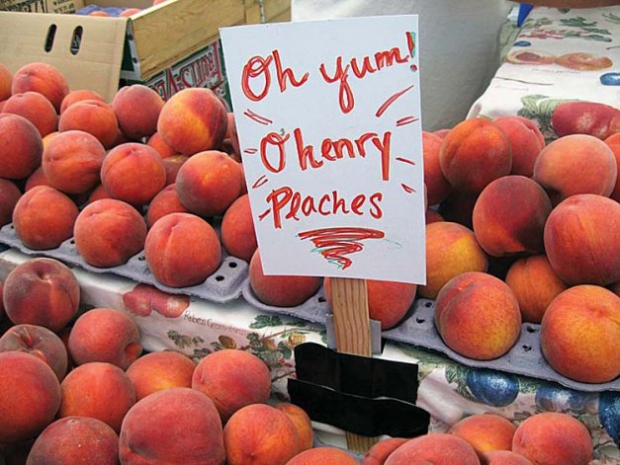
Appreciated for its red skin and golden flesh, the O’Henry peach has been an important part of the variety mix for decades.
Unlike apples and pears, where new varieties are slow to appear and stay forever, new peach varieties come, and most of them go, in a continual parade. But sometimes, a new variety comes and stays a long time. Varieties like Elberta and Redhaven fit that description, and so, too, does the variety called O’Henry.
“It was a big variety in the mid-1980s, and it still is,” said Gerry Hunter, the Northwest field representative for Burchell Nursery in Fowler, California. “It’s still among the top ten varieties planted in California, and it’s a major variety in Washington, Idaho, and Utah.”
O’Henry would do better in the East if it had resistance to bacterial spot, which it does not. It is, in fact, very susceptible. But even in the East, it is a desirable and much-planted variety.
What gives it such staying power?
Hunter explained: “When it was patented and released by Grant Merrill in 1968, most peaches were yellow with a red blush and pubescence. This one had 100 percent red color and very little fuzz. It had really good flavor. It held up in storage and shipped very well. Redhaven and Elberta did not ship without softening.”
While the variety is long ago off patent and is available through many nurseries, the folks at Burchell Nursery still consider it a special variety for them.
“We had pretty much an exclusive relationship with Grant Merrill,” Hunter said. “We selected from his selections those we thought could be commercial and propagated them. O’Henry really did well. It is still one of the few peach varieties that consumers ask for by name. It has a huge following.”
Paul Stark, Jr., writing in Fruit Varieties Journal in 1974, said that Irwin Burchell worked closely with Grant Merrill throughout his productive years.
Stark likened Merrill to Luther Burbank. He wrote that Grant Merrill was a genius in his field, and because of him, they had fresh peaches of high quality, long carrying characteristics, and attractive color to sell for six months of the year instead of two. When Merrill died in 1973, his home city of Red Bluff, California, put up a memorial to him.
Stark noted that Merrill developed more than 50 varieties good enough to patent, but said that O’Henry was Merrill’s favorite peach.
Merrill was a private breeder, not affiliated with any public program. Merrill worked with various nurseries in California that assessed tree royalty charges to commercial growers. Merrill worked mainly with peaches, but collaborated with his contemporary Fred Anderson, who did much the same kind of extensive work with nectarines. Many of Merrill’s varieties are still being grown worldwide. During the 1970s and 1980s, some 40 percent of all peaches shipped in California were Merrill cultivars.
In the patent information filed in 1968, the O’Henry tree is described as large, vigorous, productive, and an annual bearer. Fruit size is medium. It blooms midseason and is a late variety, completely freestone. One outstanding feature, besides its color, is its very short and scant pubescence. It requires 800 chill hours.
Dick Okie, the USDA peach breeder in Byron, Georgia, said: “O’Henry was a big improvement in terms of slow softening but with excellent quality and high red skin color for a late peach. It has been a mainstay in California, and used quite a bit in the East, too, despite high susceptibility to bacterial spot disease. We have gotten away from it because of the cost of the bacspot sprays.”
Because the color and size were so good, growers sometimes picked it too early to get the benefit of its excellent flavor, Okie said. He considers the peach exceptional because it is both very red and has great eating quality. Sometimes quality is sacrificed in the search for redness, he said.
Okie used O’Henry in his breeding program. “It was a parent for me of Blazeprince, from which descended Augustprince, Early Augustprince, and Scarletprince. Several California varieties are also offspring or mutations.”
Kevin Day, the University of California tree fruit advisor in Tulare County, said O’Henry “was the first of the high-red-skin colored peaches and revolutionized the industry as a consequence. It was common in the mid-1970s for O’Henry to command a $1 to $2 a box premium at a time when peaches were generally selling for $4 to $8 per box. It was also a very versatile variety that could be used for fresh, drying, or freezing purposes. It had very good flavor as well.”

Did Mr. Merrill ever discuss how he chose the name for the O’henry?
I have often wondered whether it is connected to the short story by the great author, O’ henry. titled, “Little Speck in Garnered Fruit”.
I Would like to think so, as in my opinion, the remarkable sugar profile along with the perfect balance between sweetness and acidity make the O’henry peach much more than worthy of such a quest.